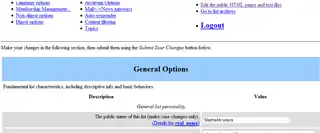 | |
 Mailman files | |
| Developer(s) | Abhilash Raj[1] |
|---|---|
| Initial release | July 30, 1999[2] |
| Stable release | |
| Written in | Mostly Python, some C |
| Operating system | Unix-like |
| Available in | Many languages |
| Type | Mailing list management software |
| License | 3: GPL-3.0-or-later 2: GPL-2.0-or-later |
| Website | www |
GNU Mailman is a computer software application from the GNU Project for managing electronic mailing lists.[4][5] Mailman is coded primarily in Python and currently maintained by Abhilash Raj.[1] Mailman is free software, licensed under the GNU General Public License.[5]
History
A very early version of Mailman was written by John Viega while a graduate student, who then lost his copy of the source in a hard drive crash sometime around 1998.[6] Ken Manheimer at CNRI, who was looking for a replacement for Majordomo, then took over development. When Manheimer left CNRI, Barry Warsaw took over. Mailman 3—the first major new version in over a decade—was released in April 2015.[7]

Features
Mailman runs on most Unix-like systems, including Linux. Since Mailman 3.0 it has required python-3.4 or newer.[8] It works with Unix-style mail servers such as Exim, Postfix, Sendmail and qmail. Features include:
- A customizable publicly-accessible web page for each maillist.
- Web application for list administration, archiving of messages, spam filtering, etc. Separate interfaces are available for users (for self-administration), moderators (to accept/reject list posts), and administrators.
- Support for multiple administrators and moderators for each list.
- Per-list privacy features, such as closed-subscriptions, private archives, private membership rosters, and sender-based posting rules.
- Integrated bounce detection and automatic handling of bouncing addresses.
- Integrated spam filters
- Majordomo-style email based commands.
- Support for virtual domains.
- List archiving. The default archiver provided with Mailman 2 is Pipermail,[9] although other archivers can be used instead. The archiver for Mailman 3 is HyperKitty.[10]
See also
References
- 1 2 Warsaw, Barry (23 November 2017). "Time Stand Still". Mailman-Announce (Mailing list). Retrieved 5 September 2018.
- ↑ Warsaw, Barry A. (30 July 1999). "Mailman 1.0". mailman-announce (Mailing list). Retrieved 2008-12-09.
- ↑ "Mailman, the GNU Mailing List Manager". gnu.org. Retrieved 2023-11-19.
- ↑ "freshmeat.net: Project details for GNU Mailman". Retrieved 2009-02-11.
- 1 2 "Mailman, the GNU Mailing List Manager". Retrieved 2009-02-11.
- ↑ "MyMailmanRole — Myriadicity Dot". Retrieved 2009-02-11.
- ↑ "Mailman 3.0 to modernize mailing lists". lwn.net. 27 March 2015. Retrieved 15 October 2015.
- ↑ "Getting started with GNU Mailman". mailman.readthedocs.org. Archived from the original on 13 October 2015. Retrieved 14 October 2015.
- ↑ "Pipermail". amk.ca. Archived from the original on 13 February 2001. Retrieved 2 February 2017.
- ↑ "Developer Resources". gnu.org. Retrieved 26 November 2015.
Further reading
Reviews
Other resources
- List Administrator's Guide
- "Mailman – An Extensible Mailing List Manager Using Python"; Ken Manheimer, Barry Warsaw, John Viega; presented at the 7th International Python Conference, Nov 10–13, 1998
- "Mailman: The GNU Mailing List Manager"; John Viega, Barry Warsaw, Ken Manheimer; presented at the 12th Usenix Systems Administration Conference (LISA '98), Dec 9, 1998
- GNU Mailman chapter in The Architecture of Open Source Applications Volume 2
- Barry Warsaw presentation on Mailman 3 at PyCon US 2012